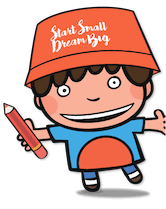“Learning to stand in somebody else’s shoes, to see through their eyes, that’s how peace begins. And it’s up to you to make that happen. Empathy is a quality of character that can change the world.”
- Barack Obama
The children’s innate curiosity was patently obvious when they noticed an International Symbol for Access outside the toilet at the beach. With their interest piqued, we went on a sign hunt back in school and discovered that we have a similar sign outside the toilet in our Light Atelier. The children were brimming with questions – What does this sign mean? Why is this sign outside this toilet and not the other toilet? Where else can we find such a sign? Who uses this toilet? Who are the people who use a wheelchair? Thus began our inquiry into how we support the needs of people with diverse abilities and relate to them sensitively and responsibly which became the focus of our school’s “Start Small, Dream Big” project.
The children first explored the concepts of form and function as they learnt more about people who are wheelchair-bound during their English inquiry and people who have visual impairment during their Chinese inquiry. They conducted observations and experiments to understand how different kinds of assistive tools, e.g. symbol of access, wheelchair, ramp, walking stick, etc. support the needs of people with diverse abilities and help them carry out their daily activities.
To extend their learning, they visited Dialogue in the Dark to understand how their experiences and perspectives differ from those of people with visual impairment.
A new friend, Sunshine, was introduced to the children so as to encourage them to reflect on how their experiences differ from people who are wheelchair-bound. Understanding that Sunshine needs help moving around the school, the children designed and made an improvised wheelchair with the help of our handyman, Mr Chang.
Interacting with Sunshine facilitated the children’s awareness that we need to be sensitive and respectful in our interactions with people with diverse abilities. It also led them to realise that all children, regardless of ability, have the right to play and that we all play a part in upholding children with diverse abilities’ right to play. In order to reinforce this idea, we visited an inclusive playground in Pasir Ris. This learning experience afforded them the opportunity to explore 3 different accessible play equipment – accessible swing, wheelchair swing and accessible merry-go-round. They spent the morning playing with Sunshine and discovering what makes each equipment accessible to children with diverse abilities.
Inspired by this experience, the children created a diorama of their ideal inclusive playground. To draw out the children’s ideas, they were encouraged to draw an individual floor plan. They then combined their ideas to make a group plan – negotiating, compromising and cooperating with their peers in the process. As the children constructed their playground model, they displayed creativity and resourcefulness in the innovative use of ideas and materials while considering the needs of children with diverse abilities.






















































